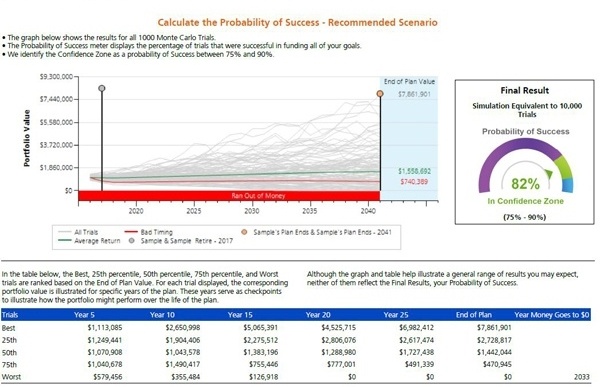When it comes to investing and retirement planning, there’s one certainty everyone must address as part of their planning: there are a lot of uncertainties.
Of course, as an investor you’ve known that all along. Market returns are unpredictable in any given year. But it doesn’t end there – investors sometimes miss the other, lesser emphasized variables that create different kinds of uncertainties over time.
We’re talking about factors like: you and your spouses’ life expectancies, the inflation rate over time, and the levels of cash flows you expect to take over your lifetime. All of these factors impact how your portfolio value will change over time.
Since all of these factors can affect your portfolio and how you manage your assets, it’s important to test their potential effects on your assets at least once a year. These tests are like going to the doctor for an annual check-up – they tell you if your assets have a high likelihood of providing you retirement income over your lifetime, and they can provide insights as to how your portfolio might grow over time.
The Utility and Benefits of a Monte Carlo Simulation
The tests we’re referring to above are called Monte Carlo simulations. To be sure, they do not provide you with certainties – but they do give you probabilities. In layman’s terms, Monte Carlo simulations are mathematical models that make projections for how your portfolio will change over time, based on doing thousands of iterations/tests with changing variables (ok, that wasn’t very layman, but bear with us).
Let’s use an example. Here are some hypothetical variables we could plug into the Monte Carlo simulation:
- You and your spouse are aged 65
- $1,000,000 portfolio
- You want cash flows of $60,000/year to start at age 68
- You each receive $20,000 in Social Security
- Asset allocation of 70% equities / 30% bonds
- Life expectancy: 90
- Expected inflation rate: 2%
Once you enter all of the data, the simulation will “stress test” your portfolio against decades and decades of potential market returns, and it will run those tests thousands of times to create a bell curve of possibilities. In doing so, it will give you the probability that your portfolio will survive until age 90, and also the probability that it will grow despite the existence of cash flows.
There’s a lot going on in the chart below, but take a moment to study it. The gray ‘squiggly’ lines in the chart represent some of the thousands of tests run. They’re potential outcomes. The green line represents an average of all the iterations, and the red line represents the outcome if the first few years of your investment generated negative returns. As you can see, in both cases you didn’t run out of money and you reached your goals.
In this case, you have an 82% “confidence” that you will reach your long-term goals. Not bad. In a majority of the tests run – some of which likely produced long stretches of negative returns – you still had money left once you reach 90. In the worst case scenario, you ran out of money in the year 2033.
This outcome was based on the hypothetical breakdown above, but the tests don’t have to end there since there are several variables you can change each time. You could test to see how the results change if your asset allocation is 80/20 or even 100% equities; you could adjust your cash flows later in life for anticipation of rising health care costs; you could change the inflation rate or your life expectancies; the list goes on.
Each simulation is likely to generate different results, which can give you insights for what your optimal asset allocation should be, and what levels of cash flows are more sustainable for you throughout retirement given your level of assets. Your financial advisor can walk you through the results and help you structure your plan for the highest probability of success.
When was the Last Time You Ran a Monte Carlo Simulation?
We think it is important to “stress test” your portfolio each year, to give you a good idea if you’re on the right track. We find much value in running through these scenarios with our clients and putting together a report of the results that our clients can keep and providing ongoing updates. Any one of the variables we plug into the simulation can change at any given time, so it’s important to look at your financial plan with flexibility to make adjustments when appropriate.
Has your advisor run a Monte Carlo simulation for you lately? You can call one of our Wealth Managers anytime and we’d be happy to create a report for you. Just give us a call at 1-800-541-7774 or contact us here to get started today.
Projections or other information generated regarding the likelihood of various investment outcomes are hypothetical in nature, do not reflect actual investment results, and are not guarantees of future results. Results may vary with each use and over time.






